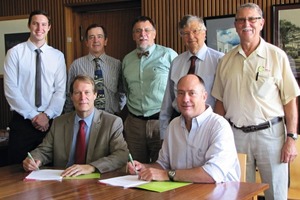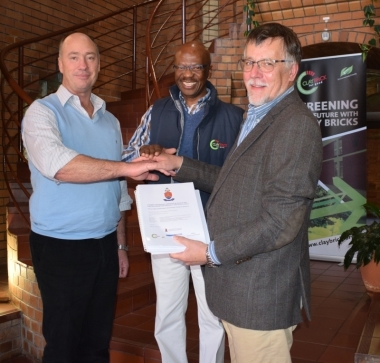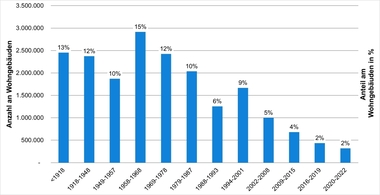Landmark agreement paves the way for life cycle assessment of clay brick
The signing of a landmark agreement between the Clay Brick Association of South Africa (ClayBrick.org) and the University of Pretoria’s Department of Architecture is to set in motion the first and largest research project of its kind ever to be undertaken in South Africa.
This groundbreaking study entitled a “Life Cycle Assessment for Clay Brick Masonry Walling in South Africa”, intends to measure the full life cycle of clay brick from cradle to cradle, and is also scheduled to be published as internationally recognized academic research.
At Coetzee, Executive Director of ClayBrick.org, explains: “With the decisions of building material specifiers being more and more influenced by the societal need for long-term sustainability, the aim is to benchmark clay brick as a green building material based on much needed factual and credible research, particularly in a South African context. Through this life cycle assessment, we will be able to calculate the environmental impacts of a clay brick building; from initial production of the material to construction, and overall operation, in terms of energy usage, water consumption, resultant greenhouse gas emissions and recyclability, among others. The thermal performance of clay brick walling structures will also be compared to newer methods, like the light steel framed walling systems.”
Project Coordinator at the University of Pretoria, Professor Piet Vosloo adds: “From the university‘s perspective the overall aim of the study is to conduct a comprehensive life cycle assessment of clay bricks according to internationally accepted benchmarks.”
The Clay Brick LCA study will be rolled out in a two-phased approach. The first stage will include a detailed life cycle assessment to determine the environmental impact of clay brick from raw material extraction through to manufacture, transportation, construction on-site, as well as the operational life of the building, and also the demolition, disposal and recycling thereof.
As part of the second phase, a thermal modelling study offering comparative data between the thermal performance of clay brick walling and other alternative walling structures will be undertaken. The designs for comparison will include a 40 m2 house, a 130 m2 house, as well as a small office design of ± 2 000 m2. The wall constructions to be compared include:
› Double brick cavity wall (un-insulated)
› Insulated double brick
› Light steel frame
› 140 mm hollow concrete block
› Timber frame clad with fibre board
The performance of each of these construction methods will be assessed across the six climatic zones of South Africa, and in accordance with the guidelines of SANS 10400XA, which is the building regulation for energy efficiency and energy use in this country.
Says technical consultant, Howard Harris of Structatherm Projects: “Building professionals and/or property owners who wish to be leading on the path to sustainability are moving towards making decisions on products that ‘tread more lightly on the planet’. Clay brick as a product has good environmental credentials when compared with industrialized systems like steel/aluminium (based on international research). This data needs to be available for the industry and building professionals to see where improvements can and should be made.“
Furthermore, new legislation and the pending implementation of Green Tag labelling are also key considerations. “It is essential to have an accurate picture of where clay brick products lie in the green building spectrum”, adds Harris.
The Clay Brick Life Cycle Assessment will follow the broader scope and methodology as that undertaken by Energetics and commissioned by Think Brick, Australia – the sister organization to the Clay Brick Association in that country. This is due to similar climatic zones, with the South African research anticipated to follow comparable trends to the Energetics Australia LCA study.
“Other common factors that have an influence include the electrical power usage intensity, building methods, as well as coal and gas costs which are very similar between Australia and South Africa, and the fact that significant distances need to be covered by distributors of clay brick building products to reach the building sites”, says Harris. “In the South African study, the socio-economic aspects will also be looked at in greater detail due to employment creation within the bricklaying and associated sectors being an urgent imperative.”
The value of the industry as an employer and the economic multiplier impacts thereof will also be explored as an extension of the LCA study, with the clay brick masonry industry as a provider of jobs, and a means of wealth creation, in terms of assets highlighted. The Clay Brick Life Cycle Assessment will be an ongoing study as it maps out the improvements made to all the metrics into the future.
“What this research means to the clay brick industry is that we will be able to maintain the high ground when we talk about our products, particularly in a green building context so as to bypass any potential of being labelled as greenwashing. We are proud of the partnering relationship established with the University of Pretoria and look forward to working with Professor Vosloo and his team in proving the sustainability of clay brick”, concludes At Coetzee.







